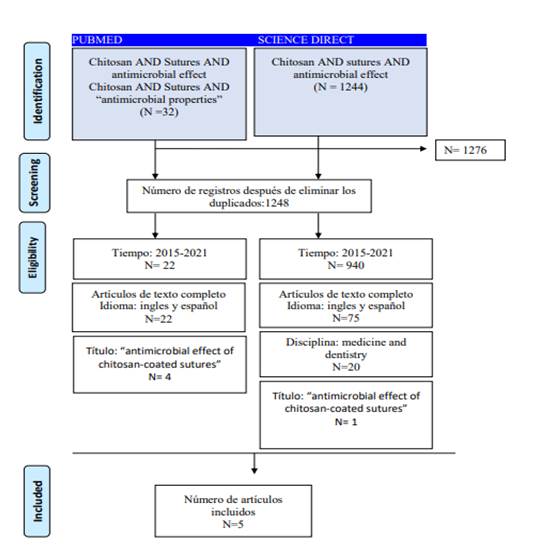Resumo
As infecções pós-operatórias são cada vez mais comuns, assim como o aumento dos mecanismos de resistência bacteriana a uma diversa classe de antibióticos de longo espectro, razão pela qual surgiu agora a necessidade de procurar materiais de origem natural com propriedades antimicrobianas e biocompatíveis, que pode prevenir várias complicações relacionadas a infecções pós-operatórias. O objetivo desta revisão sistemática é contextualizar a eficácia antimicrobiana da quitosana utilizada no revestimento de suturas em cirurgia bucomaxilofacial. A estratégia de busca foi realizada em dois bases de dados: PubMed e ScienceDirect de fevereiro a 18 de outubro de 2021. Foram seguidas as diretrizes PRISMA (Preferred Reporting Items for Systematic Reviews and Meta-Analyses). De acordo com nossos resultados, os cinco artigos incluídos de estudos in vitro e in vivo mostraram que o revestimento das suturas com quitosana inibe microrganismos do tipo Gram (+) e Gram (-), apresentando maior atividade contra espécies Gram. (-). Conclui-se também que o revestimento das suturas com quitosana pode substituir e melhorar as propriedades das suturas antimicrobianas atualmente comerciais, além de reduzir infecções pós-operatórias e acelerar os processos de cicatrização.
Referências
2. Frank LA, Onzi GR, Morawski AS, Pohlmann AR, Guterres SS, Contri RV. Chitosan as a coating material for nanoparticles intended for biomedical applications. Reactive and Functional Polymers. 2020; (147):104459.
3. Cicciú M, Fiorillo L, Cervino G. Chitosan use in dentistry: systematic review of recent clinical studies. Mar Drugs 2019;17(7):417.
4. Chenxi Z, Didi H, Colin D, Huan S, Wei P, Xiaobing P, Zhengyong L, Jianxun S, Changchun Z. Preparation and application of chitosan biomaterials in dentistry. Review. Int J Biol Macromol 2021;15(167):1198-1210.
5. Poblete F, Dallaserra M, Yanine N, Araya I, Cortés R, Vergara C, Villanueva J. Incidencia de complicaciones posquirúrgicas en cirugía oral. Int J Interdiscip Dent 2020; 13(1):13-16.
6. Despaigne I, Rodríguez Z, Pascual M, Lozada GA, Mustelier HL. Consideraciones actuales sobre las infecciones posoperatorias. Review. MEDISAN. 2013;17(4): 686-707.
7. Lestari W, Yusry WN, Haris MS, Jaswir I, Idrus E. A glimpse on the function of chitosan as a dental hemostatic agent. Japan Dental Science Review 2020;56(1):147-154.
8. Viju S, Thilagavathi G. Effect of chitosan coating on the characteristics of silk-brained sutures. Journal of Industrial Textiles 2012;42(3):256-268.
9. Minozzi F, Bollero P, Unfer V, Dolci A, Galli M. The sutures in dentistry.Eur Rev Med Pharmacol Sci 2009;13(3):217-26.
10. Shlomo M, Avital K, Anda KS, Levartovskya Y, Mazora H. The effect of commonly used sutures on inflammation inducing pathogens – An in vitro study. J Craniomaxillofac Surg 2013;41(7):593-7.
11. Xiaojie C, Dandan H, Xiaoqi T, Lu W. Quantitative physical and handling characteristics of novel antibacterial braided silk suture materials. J Mech Behav Biomed Mater 2015;(50):160-70.
12. Ayala G. Efecto antimicrobiano del quitosano: una revisión de la literatura. Scientia Agroalimentaria. 2015;(2):32-38.
13. Clayton EM, Todd M, Dowd JB, Aiello AE. The impact of bisphenol A and triclosan on immune parameters in the U.S. population, NHANES 2003-2006. Environ Health Perspect. 2011;119(3):390-6.
14. Serrano C, García L, Fernández JP, Barbeck M, Ghanaati S, Unger R, Kirkpatrick J, Arzt E, Funk L, Turon P, del Campo A. Nanoestructured medical sutures with antibacterial properties. J Biomaterials. 2015;(52):291-300.
15. Hutton B, Ferrán C, López F., Moher D. La extensión de la declaración PRISMA para revisiones sistemáticas que incorporan metaanálisis en red: PRISMA-NMA. Medicina. 2016;(16):262-266.
16. Masood R, Hussain T, Umar M, Azeemullah, Areeb T, Riaz S. In situ development and application of natural coatings on non-absorbable sutures to reduce incision site infections. J Wound Care. 2017;26(3):115-120.
17. Prabha S, Sowndarya J, Ram PJVS, Rubini D, Hari BNV, Aruni W, Nithyanand P. Chitosan-Coated Surgical Sutures Prevent Adherence and Biofilms of Mixed Microbial Communities. Curr Microbiol 21;78(2):502-512.
18. Debbabi F, Gargoubi S, Hadj Ayed MA, Abdessalem SB. Development and characterization of antibacterial braided polyamide suture coated with chitosan-citric acid biopolymer. J Biomater Appl 2017;32(3):384-398.
19. Mohammadi H, Alihosseini F, Hosseini SA. Improvement of the physical and biological properties of monofilament nylon as chitosan/hyaluronic acid suture. Int J Biol Macromol 2020; 164:3394-3402.
20. Yang Y, Yang SB, Wang YG, Zhang SH, Yu ZF, Tang TT. Bacterial inhibition potential of quaternised chitosan-coated
VICRYL absorbable suture: An in vitro and in vivo study. Journal of orthopaedic translation. 2016;11(8):49-61.
21.Kong M, Chen XG, Xing K, Park HJ. Antimicrobial properties of chitosan and mode of action: A state of the art review.
International Journal of Food Microbiology. 2010;144(1):51-63.
22. Yuanhong L, Ya-Qui C, Chen- Hao Y, Yu X, Meng.Ying X, Chao-Liang Z, Xianglong H, Qiang P. Drug-free and non-cross-linked chitosan scaffolds with effective antibacterial activity against Gram-negative and Gram-positive bacteria. Carbohydrate Polymers. 2020;(241):116386.
23. H. Bellanger, Casdorff K, F. Muff L, Ammann R, Burgert I, Michen B. Layer-by-layer deposition on heterogeneous surface: Effect of sorption kinetics on the growth of polyelectrolyte multilayers. Journal of Colloid and Interface Science.2017;(500):133-141.


